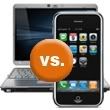By Amy Vale
 Have you noticed that consumers shop in a totally different way to how they might have ten or even five years ago? No longer do people compare two or three products at home and then go into the store to make their purchase. In fact, the emerging trend now is for consumers to do the shopping research via their mobile devices while they are actually standing in the store. This is a process which has come to be known as “showrooming.” According to a recent study by Pew Research, 52% of American shoppers use their smartphone to perform research while standing in the aisle of a store, and what’s more is that 19% of these “showroomers” convert their offline/in-store purchase to an online retailer. What does all this mean for retailers?
Have you noticed that consumers shop in a totally different way to how they might have ten or even five years ago? No longer do people compare two or three products at home and then go into the store to make their purchase. In fact, the emerging trend now is for consumers to do the shopping research via their mobile devices while they are actually standing in the store. This is a process which has come to be known as “showrooming.” According to a recent study by Pew Research, 52% of American shoppers use their smartphone to perform research while standing in the aisle of a store, and what’s more is that 19% of these “showroomers” convert their offline/in-store purchase to an online retailer. What does all this mean for retailers? The traditional retail business model has fundamentally changed. Ten or fifteen years ago retailers had greater control over the flow of information that went to consumers, and there wasn’t nearly as much choice. Now, because there is so much information, so many alternatives, and the ability to compare and shop around while actually doing the act of shopping, retailers know that mobile has changed the way people shop, and they need to get on board with this fact or they’ll miss the train to mcommerce city.
We have been hearing a lot of “brick-and-mortar” retailers getting stressed about the fact that they are losing business to online-retailers. There is no denying that this shift in the way people shop has happened. Many people are shopping online rather than actually going into a store, because of convenience and with the goal of getting the best price. The real challenge for retailers now is to join forces with mobile; that is, bridge the virtual world of e-commerce with the physical one. We know that consumers are using their smartphones while shopping, so retailers should find ways to capitalize on this and align themselves with the way consumers are shopping today.
The proliferation of QR codes is one example of how retailers have found a way of connecting the virtual or digital with the physical; using social media to connect with consumers and build brand presence in non-traditional places like Foursquare and other mobile apps that can also serve as the perfect mechanism for bridging the online and offline consumer. Consider things such as in-store check-in, e-commerce and in-store checkout, and the “virtual aisle”, which provides the ability to scan and order products via other media such as billboards and flyers. The lesson here is to find ways to blur the boundaries between the online and offline environment. If shoppers want to use their mobiles and smartphones while shopping, you have to find a way to make this work for you, and them.
Retailers should not see mobile and “showroom shopping” as a negative outcome of the shift in consumer behaviour, but rather as an opportunity to grow and head into the new retail sphere. It has become quite clear that retailers who wish to stay relevant need to embrace mobile as the future of the consumer experience.



